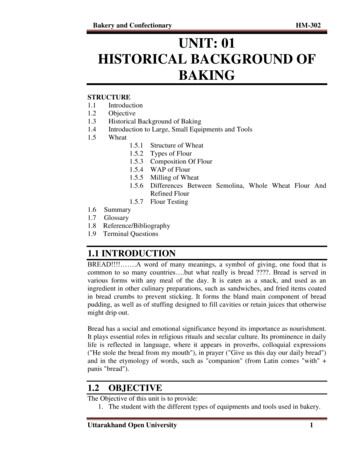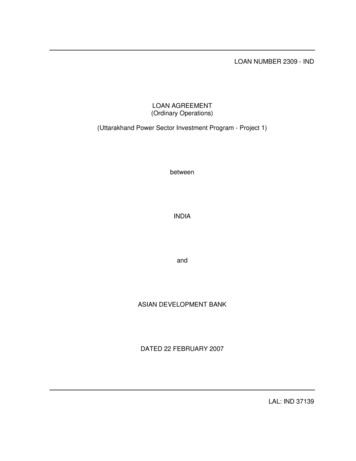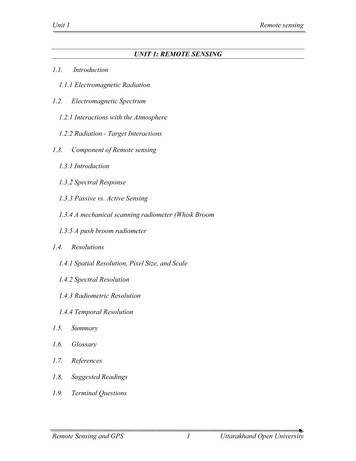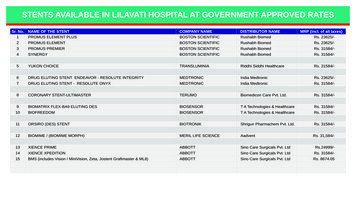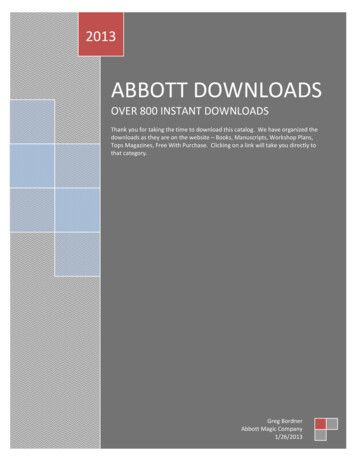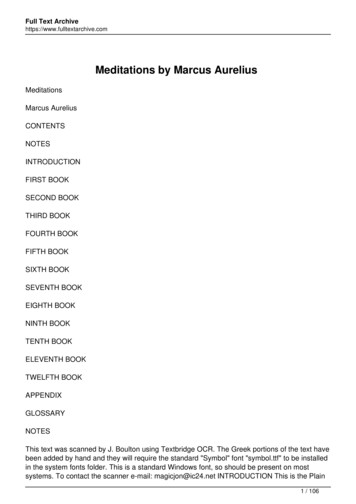
Transcription
LILAVATI (BHASKARA II BOOK)Dr. Shivangi UpadhyayUttrakhand Open University, Haldwani (Uttarakhand)supadhyay@uou.ac.inDr. Shivangi UpadhyayLILAVATI (BHASKARA II BOOK)1 / 101
AbstractLilavati (Lilavati) was composed by renowned astronomer andmathematician Bhaskaracarya (Bhaskara II) (b. 1114 AD) in 1150.This is the first volume of his main work Siddhanta Shiromani(”Crown of treatises”) alongside Bijaganita, Grahaganita andGoladhyaya.Lilavati is a comprehensive exposition of arithmetic, algebra,geometry, mensuration, number theory and related topics.Dr. Shivangi UpadhyayLILAVATI (BHASKARA II BOOK)2 / 101
Lilavati is the most celebrated work in the tradition of Mathematicsin India.This highly important textbook has been used for almost 85 yearsand is still used as a textbook in many Sanskrit institutions in India.This articulate, scholarly and legendary presentation has beentranslated into several languages of the world.This textbook deals mainly with ’Arithmetic’ and consists of 279verses written in Sanskrit in poetic form (terse verses) with aprose commentary.Dr. Shivangi UpadhyayLILAVATI (BHASKARA II BOOK)3 / 101
This book contains a number of interesting, poetic problems,which give a flavour of ancient Indian school problems.The concepts and methods developed in Lilavati are significanteven today and are beneficial to school-going children,sophomores, teachers, scholars, historians and those working forthe cause of mathematics.This book is also useful to students appearing in variouscompetitive examinations to degree and professional courses inIndia, where calculator is not allowed.The aim of this talk is to present some highlights and discusscertain significant aspects Lilavati in 21st Century.Dr. Shivangi UpadhyayLILAVATI (BHASKARA II BOOK)4 / 101
IntroductionIn ancient India mathematics was family-based. Mathematicaleducation was largely restricted within the family and there wasnot much scope of innovation. Father passed on thecommentaries to his son, who pursued it.The role of women in mathematics during those times was highlyrestricted or even probably non-existent. Religion also played akey role.Mathematical beliefs were tantamount to religious beliefs andchanging religious beliefs was not acceptable. The role ofcommentaries was important because mathematicians wrotecommentaries on their own work and the work of theirpredecessors.These commentaries got transferred in disclipinic succession.Dr. Shivangi UpadhyayLILAVATI (BHASKARA II BOOK)5 / 101
Bhaskara II (1114 - 1185 A.D.) also known as Bhaskharacharyawas born in Maharashtra.He is considered as an outstanding poet-mathematician of histimes.He was the head of the astronomical observatory at Ujjain, whereother famous Indian mathematicians including Brahmagupta hadstudied and worked previously. He worked on algebra, numbersystems, and astronomy.He wrote beautiful texts illustrated with mathematical problemsand he provided the best summary of the mathematics andastronomy of the classical period.Dr. Shivangi UpadhyayLILAVATI (BHASKARA II BOOK)6 / 101
He made fundamental contributions to the development of numbertheory, the theory of indeterminates infinite series expressions forsine, cosine and tangent, computational mathematics, etc. 200years after Bhaskara did any significant work happened in IndianMathematics.Bhaskara was a great poet and had mastered eight volumes onGrammar, six on medicine, six on logic, five on mathematics, fourvedas, a triad of three ratnas and two Mimamsas.Dr. Shivangi UpadhyayLILAVATI (BHASKARA II BOOK)7 / 101
Bhaskara produced six works during his lifetime: Lilavati,Bijaganita, Siddhantasiromani, Vasanabhasya of Mitaksara,Brahmatulya, and Vivarana.These were all books on math or astronomy, with some of thembeing commentaries on his own works or that of others.Bhaskara was excellent at arithmetic, including a goodunderstanding of negative and zero numbers. He was also goodat solving equations and had an understanding of mathematicalsystems, years ahead of his European peers.Dr. Shivangi UpadhyayLILAVATI (BHASKARA II BOOK)8 / 101
Bhaskaracarya himself never gave any derivations of his formulae.Emperor Akbar commissioned a Persian translation of the Lilavatiin 1587 and Faizi (brother of Akbars vizier, Abul Fazl) executed it.According to Faizi, Lilavati was Bhaskaracharya’s daughter.Dr. Shivangi UpadhyayLILAVATI (BHASKARA II BOOK)9 / 101
Lilavati is the first part of Bhaskaracharyas workSiddhantashiromani that he wrote at the age of 36.Siddhantashiromani consists of four parts namely1. Lilavati2. Algebra3. Planetary motions and4.Astronomy.Lilavati has an interesting story associated with how it got itsname.Dr. Shivangi UpadhyayLILAVATI (BHASKARA II BOOK)10 / 101
Bhaskaracharya created a horoscope for his daughter Lilavati, andpredicted that she would remain both childless and unmarried.To avoid this fate, he ascertained an auspicious moment for hisdaughter’s wedding and to alert his daughter at the correct time,he placed a cup with a small hole at the bottom of a vessel filledwith water, arranged so that the time at which the cup sank wasthe optimum time Lilavati was to get married (water-clock).He put the device in a room with a warning to Lilavati not go nearit.In her curiosity though, she went to look at the device and a pearlfrom her bridal dress accidentally dropped into it, thus upsetting itand blocking the hole and the lucky hour passed without the cupsinking.Dr. Shivangi UpadhyayLILAVATI (BHASKARA II BOOK)11 / 101
The auspicious moment for the wedding thus passed unnoticedleaving a devastated Bhaskaracharya. Lilavati was then doomednever to wed.The wedding went on as planned but her husband died soon afterthe ceremony.To console his daughter, who remained a widow the rest of herlife, Bhaskara promised to name a book after her and named itLilavati (The Beautiful), one that would remain till the end of timeas a good name is akin to a second life.Even now, it is used in some Sanskrit schools. It should beremembered that Lilavati served as a textbook for nearly 800years in different parts of India until the British system ofeducation was introduced.This is something worth emulating in order to make education ofmathematics interesting, exciting and also fun.Dr. Shivangi UpadhyayLILAVATI (BHASKARA II BOOK)12 / 101
Many of the problems are addressed as questions to his beloveddaughter, Lilavati herself who must have been a very bright youngwoman.For Example ”Oh Lilavati, intelligent girl, if you understand additionand subtraction, tell me the sum of the amounts 2, 5, 32, 193, 18,10, and 100, as well as [the remainder of] those when subtractedfrom 10000.” and ”Fawn-eyed child Lilavati, tell me, how much isthe number [resulting from] 135 multiplied by 12, if you understandmultiplication by separate parts and by separate digits. And tell[me], beautiful one, how much is that product divided by the samemultiplier”Dr. Shivangi UpadhyayLILAVATI (BHASKARA II BOOK)13 / 101
Leelavati was written in 1150, before the days of printing, whenthe material and equipment required for making permanent writtenrecords were not abundant.Therefore, like almost all of the scientific and philosophical workswritten in Sanskrit, Leelavati is also composed in verse form sothat pupils could memorise the rules without the need to refer towritten texts.Dr. Shivangi UpadhyayLILAVATI (BHASKARA II BOOK)14 / 101
Contents of Lilavati.There are certain verses which deal with Mensuration(measurement of various geometrical objects), Volume ofpyramid, cylinders, heaps of grains etc., wood cutting, shadows,trigonometric relations and also on certain elements of Algebrasuch as finding an unknown quantity subject to certain constraintsusing the method of supposition.The book contains thirteen chapters and covers many branches ofmathematics, arithmetic, algebra, geometry, and a littletrigonometry and mensuration.Dr. Shivangi UpadhyayLILAVATI (BHASKARA II BOOK)15 / 101
More specifically the contents include: definitions, properties ofzero (including division, and rules of operations with zero),extensive numerical work, including use of negative numbers andsurds, estimation of π,arithmetical terms, methods ofmultiplication, squaring, inverse rule of three, and rules of 3, 5, 7,9, and 11, interest computation, arithmetical and geometricalprogressions, plane geometry, solid geometry, the shadow of thegnomon, the kuttaka - a method to solve indeterminate equations,integer solutions (first and second order) and combinations.His contributions to this topic are particularly important, since therules the given are (in effect) the same as those given by therenaissance European mathematicians of the 17th century, yet hiswork was of the 12th century.Dr. Shivangi UpadhyayLILAVATI (BHASKARA II BOOK)16 / 101
Bhaskara’s method of solving was an improvement of the methodsfound in the work of Aryabhata and subsequent mathematicians.Bhaskara II gives the value of π as 227 in the book but suggest a3927more accurate ratio of 1250 for use in astronomical calculations.Also according to the book, the largest number is the parardhaequal to one hundred thousand billion.Lilavati includes a number of methods of computing numbers suchas multiplications, squares and progressions with examples usingkings and elephants, objects that a common man couldunderstand.Dr. Shivangi UpadhyayLILAVATI (BHASKARA II BOOK)17 / 101
Excerpt from Lilavati (Appears as an additional problem attachedto stanza 54, Chapter 3. Translated by T N Colebrook)Whilst making love a necklace broke.A row of pearls mislaid.One sixth fell to the floor.One fifth upon the bed.The young woman saved one third of them.One tenth were caught by her lover.If six pearls remained upon the stringHow many pearls were there altogether?Dr. Shivangi UpadhyayLILAVATI (BHASKARA II BOOK)18 / 101
1971: Professor Phadke translated Lilavati of Bhaskaracharya (ATreatise of Mathematics of Vedic Tradition) in Marathi titled LilavatiPunardarshana - A New Light in 1971.He took great pains in writing the excellent Marathi translation withcomments and explanation of the rationale of Lilavati in terms ofmodern mathematics.Krishnaji Shankara Patwardhan, Somashekhara Amrita Naimpallyand Shyam Lal Singh [1] translated their Marathi work in toEnglish.1816: John Taylor, Lilawati: or A Treatise on Arithmetic orGeometry by Bhascara Acharya1817: Henry Thomas Colebrooke, Algebra, with Arithmetic andmensuration, from the Sanscrit of Brahmegupta and Bhscara,Page 24, chap 2/3.Dr. Shivangi UpadhyayLILAVATI (BHASKARA II BOOK)19 / 101
1971: Professor Phadke , ”Lilavati of Bhaskaracharya (A Treatiseof Mathematics of Vedic Tradition)” in Marathi titled LilavatiPunardarshana - A New Light in 1971.He took great pains in writing the excellent Marathi translation withcomments and explanation of the rationale of Lilavati in terms ofmodern mathematics.1975: K. V. Sarma, Lilavati of Bhaskaracarya withKriya-kramakari, Hoshiarpur: VVBIS & IS, Panjab University.2001: K. S. Patwardhan, S. A. Naimpally and S. L. Singh. Lilavatiof Bhaskaracarya: a treatise of mathematics of Vedic tradition:with rationale in terms of modern mathematics largely based onN.H. Phadke’s Marathi translation of Lilavati.Dr. Shivangi UpadhyayLILAVATI (BHASKARA II BOOK)20 / 101
He was the first to recognize that certain types of quadraticequations could have two solutions.His Chakrawaat method of solving indeterminate solutionspreceded European solutions by several centuries.Bhaskaracharya wrote this work by selecting good parts fromSridharacharya’s Trishatika, Mahaviracharya’sGanitasarasamgraha, some parts of Brahmagupta, &Padmanabha and adding material of his own.However his work is outstanding for its systemisation, improvedmethods and the new topics that he has introduced. Furthermorethe Lilavati contained excellent recreative problems and it isthought that Bhaskara’s intention may have been that a student of’Lilavati’ should concern himself with the mechanical application ofthe method.Dr. Shivangi UpadhyayLILAVATI (BHASKARA II BOOK)21 / 101
Lilavati became quite popular in India during the time it was firstcomposed. Handwritten copies of Lilavati replaced most otherprevalent texts of those times and eventually reached othercountries.Lilavati does not contain much of algebra, at least not explicitly.Also, the verses, which deal with Permutations, are separate fromthat of Combinations. The former appears before the verses onGeometry and the later appears after.In the Lilavati the eight mathematical operations (parikarmastaka),addition, subtraction, multiplication, division, squaring, cubing,extraction of square and cube-roots are dealt with first. Theoperations with zero (sunyaparikarma) follow.Dr. Shivangi UpadhyayLILAVATI (BHASKARA II BOOK)22 / 101
Then come vyastavidhi (method of inversion), istakarma (unitarymethod), sankramana (finding a & b when a b and a-b are knowni.e., the method of elimination), vargasankramana (finding a & bfrom a b and a2 b2 , vargakarma (finding a & b so thata2 b2 1 and a2 b2 1 may be perfect squares), mulagunaka(problems involving square roots i.e. those which lead to quadraticequations); [trairasika (rule of three); bhandapratibhandaka(barter), misravyavalara (mixtures), srenivyavahara (series);ankapasa (permutations and combinations) and kuttaka(indeterminate analysis).In fact, some of these topics like series, permutations andcombinations and indeterminate analysis more properly comeunder algebra.The section on geometry (ksetraganita) opens with theenunciation of the theorem of the square of the hypotenuse.Dr. Shivangi UpadhyayLILAVATI (BHASKARA II BOOK)23 / 101
But the enunciation is algebraic rather than geometrical and leadson to the solution of rational right triangles and height anddistance problems.The condition for given lengths of sides forming the sides of aclosed rectilinear figure is then given. The rules for calculating theattitude, area, etc., of triangles and different types of quadrilateralscome next.After criticising Brahmagupta’s rule for finding the diagonals ofquadrilaterals, he gives his method of getting a rationalquadrilateral by the juxtaposition of rational right triangles andshows how the diagonals are then easily found.Circles are dealt with next, a very satisfactory approximateformula for calculating the arc in terms of the chord and vice versawere given, so also are given the correct expressions for thevolume and surface of a sphere.Dr. Shivangi UpadhyayLILAVATI (BHASKARA II BOOK)24 / 101
Though Sridhara before Bhaskara gave the correct expression forthe volume, Bhaskara’s is in more general terms. The sides ofrectilinear figures with 3,4,.,9 sides are calculated next.Khatavyavahara (section on excavations) and krakacavyavahara(shadow problems) cover some interesting problems.Except for the section on permutations and combinations, thescheme is the same as that in the mathematical chapters of theBrahmasphuta siddhanta.But Bhaskara’s treatment is always richer and morecomprehensive.Dr. Shivangi UpadhyayLILAVATI (BHASKARA II BOOK)25 / 101
ArithmeticArithmeticThe first verse of Lilavati is an invocatory verse on Lord Ganesha,the god of wisdom, as it was customary in those days before thebeginning of any auspicious event. Lilavati begins:”Salutation to the elephant-headed Being who infuses joy into theminds of his worshippers, who delivers from every difficulty thosewho call upon him and hose feet are reverenced by the gods.”Here the word Pati is used for Arithmetic.It literally means slate mathematics.Dr. Shivangi UpadhyayLILAVATI (BHASKARA II BOOK)26 / 101
The verse also claims that discriminating people because of itsclarity, brevity as well as literary flavour love this work. This showsthe literary significance of the work.Following the invocation, the next 9 verses deal with definitions ofmeasurement units for various things.Firstly, he defines the various units of money, which were in vogueduring those days.This is followed by measures of gold, units of length, measures ofgrain in volume and lastly the measure of time. This indicates thatthe text is quite formal in treatment.Also, the fact that Arithmetic is directly related to commerce isevident.It sets the tone of the work not as an abstract piece but rather oneof practical significance in day-to-day applications.Dr. Shivangi UpadhyayLILAVATI (BHASKARA II BOOK)27 / 101
This contrasts with other works of the time where mathematicaltexts were not necessarily justifying their use in everyday life.There is a reference to the measure of grains as being Turkish inverse 9.It appears that his verse must be an inserted verse since therewas no influence of Muslims either in the north or in the southduring Bhaskaracharyas times and that it was unlikely that theywere in common use.The next two verses define the all-important positional notation ofdigits and their values.Dr. Shivangi UpadhyayLILAVATI (BHASKARA II BOOK)28 / 101
It clearly states that the value of digits increase by a factor tenfrom right to left.The highest value defined is parardha 1017 . The fact thatBhaskaracharya was an astronomer probably justifies the need forsuch high magnitudes, which may be required for describing largecelestial distances.The author claims that the highest value defined in Sanskrit (not inthis work) is 10140 .It is not clear as to what would be the use of such a high numberbecause the number of atoms in the universe is only about 1080 .It is also interesting to note that absolutely no reference tonumerals of any kind is explicitly mentioned, though it is knownthat Brahmi numerals that were invented in the first century A.D.were used.Dr. Shivangi UpadhyayLILAVATI (BHASKARA II BOOK)29 / 101
This is a page from a manuscript of the Lilavati of Bhaskara II(1114-1185). This manuscript dates from 1650. The rule for theproblem illustrated here is in verse 151, while the problem itself isin verse 152:Dr. Shivangi UpadhyayLILAVATI (BHASKARA II BOOK)30 / 101
Dr. Shivangi UpadhyayLILAVATI (BHASKARA II BOOK)31 / 101
151: The square of the pillar is divided by the distance betweenthe snake and its hole; the result is subtracted from the distancebetween the snake and its hole. The place of meeting of thesnake and the peacock is separated from the hole by a number ofhastas equal to half that difference. 152: There is a hole at thefoot of a pillar nine hastas high, and a pet peacock standing on topof it. Seeing a snake returning to the hole at a distance from thepillar equal to three times its height, the peacock descends upon itslantwise. Say quickly, at how many hastas from the hole does themeeting of their two paths occur? (It is assumed here that thespeed of the peacock and the snake are equal.)Dr. Shivangi UpadhyayLILAVATI (BHASKARA II BOOK)32 / 101
These verses and much else from the Lilavati may be found in KimPlofker, ”Mathematics in India”, in Victor Katz, ed., TheMathematics of Egypt, Mesopotamia, China, India, and Islam: ASourcebook (Princeton: Princeton University Press, 2007), pp.385-514.Dr. Shivangi UpadhyayLILAVATI (BHASKARA II BOOK)33 / 101
Dr. Shivangi UpadhyayLILAVATI (BHASKARA II BOOK)34 / 101
This page from the Lilavati gives another illustration of thePythagorean Theorem. Frank J. Swetz and Victor J. Katz,”Mathematical Treasures - Lilavati of Bhaskara,” Loci (January2011)Dr. Shivangi UpadhyayLILAVATI (BHASKARA II BOOK)35 / 101
Addition and SubtractionThe next few verses describe the method (or technique oralgorithm) to add two numbers in the positional system.This is the characteristic of the entire work - the verses describethe method in an algorithmic fashion. The verse itself is terse andthere are no elaborate explanations of any kind.This is very contrasting to the scientific and mathematical works ofthe Greeks that are usually verbose.An important thing to observe is that the verse claims that bothaddition and subtraction could be performed place-wise eitherfrom right to left or vice-versa.There also seems to be no mention of a carry-over whenever thesum of digits exceeded 9 (it was a base-10 system).Dr. Shivangi UpadhyayLILAVATI (BHASKARA II BOOK)36 / 101
However, it is possible that these were left as an exercise to thestudent to workout the details. It is also possible that there was anintermediate step instead of a carry-over. An example isdemonstrated here:tensunits26 87—————————— 10,13——————————–As it can be seen, in the above addition (either from left-to-right orright-to-left), carry- over is not employed.The sum for both the units and tens positions have exceed 9, butare retained as it is.Dr. Shivangi UpadhyayLILAVATI (BHASKARA II BOOK)37 / 101
There is a comma placed in order to identify the positionalnotation.This makes intuitive sense because 10 in the tens place is notallowed, but all it means is 10 10 100.Similarly, 13 in the units place is not allowed, but it means just 13.Hence, we perform the addition of these two as the next step:hundredstensunits100 �————— �———————–Dr. Shivangi UpadhyayLILAVATI (BHASKARA II BOOK)38 / 101
This procedure is repeated until the final result has each digit 10 in the positional notation.In the above example, we stop after the second step.Although this seems cumbersome and requires more steps, thereare two advantages:1. This procedure could be performed either from left-to-right orfrom right-to-left and would ultimately yield the same result.This is not true with the modern carry-over method. In fact, in thismethod, addition can be arbitrarily performed starting from anypositional value and in any order. The result would be the same.Dr. Shivangi UpadhyayLILAVATI (BHASKARA II BOOK)39 / 101
The carry-over method requires the operation to be performedstrictly from right to left.2. For subtraction, a slight modification is necessary toincorporate this method.Assume that we wish to subtract 36 from 10000. We will have tosplit 10000 as 9999 1.We could perform 9999 - 36 in the same way as above to yield9963. We then perform 9963 1 9964 to arrive at the finalanswer.It is quite possible that Bhaskaracharya performed such splittingbecause elsewhere in giving methods for multiplication, heperforms such splitting of numbers to simplify the procedure.This is purely a speculation part. The illustrious Bhaskaracharyaand his students may have been aware of the carryover method.Dr. Shivangi UpadhyayLILAVATI (BHASKARA II BOOK)40 / 101
Multiplication and DivisionBhaskaracharya gives 5 different methods for multiplication.They involve various tricks like splitting the multiplier into twoconvenient parts and multiplying the multiplicand by each of thetwo parts and adding the results; factoring the multiplier,multiplying by each factor and then summing up the results etc.Another interesting characteristic of each of these methods is thatBhaskaracharya challenges the student following the introductionof each method by giving a problem/s to test the understanding ofthe student.Solutions are not provided but these examples are straightforward.Dr. Shivangi UpadhyayLILAVATI (BHASKARA II BOOK)41 / 101
He typically expects all the methods to be used to ensure that thesolution is consistent. The verses are also quite poetic andbeautiful.The use of poetic language typically involves the use of suchadjectives and similies as - ’O! Auspicious girl with lovable eyes ofa young dear’, ’Oh Friend!’, ’My beloved’, ’Deer-eyed’,’Fickle-eyed’, ’Oh! you intelligent girl Lilavati’ etc.This clever use of language is partly teasing but also engagingand challenging the student intellectually.This is quite contrasting to modern mathematical textbooks, whichare always in prose form and quite dry.Elsewhere, Bhaskaracharya employs humour quite effectivelywhich is also lacking in present day textbooks.Bhaskaracharya gave two methods of multiplication in his Lilavati.Dr. Shivangi UpadhyayLILAVATI (BHASKARA II BOOK)42 / 101
1.To multiply 325 by 243 Bhaskaracharya writes the numbers thus:243 243 243325——————Now working with the rightmost of the three sums he computed 5times 3 then 5 times 2 missing out the 5 times 4 which he did lastand wrote beneath the others one place to the left.Note that this avoids making the ”carry” in ones head.243 243 r. Shivangi UpadhyayLILAVATI (BHASKARA II BOOK)43 / 101
Now add the 1015 and 20 so positioned and write the answerunder the second line below the sum next to the left.243 243 15Dr. Shivangi UpadhyayLILAVATI (BHASKARA II BOOK)44 / 101
Work out the middle sum as the right-hand one, again avoidingthe ”carry”, and add them writing the answer below the 1215 butdisplaced one place to the left.243 243 243325——————4 6 10158 20——————1215486Dr. Shivangi UpadhyayLILAVATI (BHASKARA II BOOK)45 / 101
Finally work out the left most sum in the same way and againplace the resulting addition one place to the left under the 486.243 243 243325——————6 9 4 6 101512 8 r. Shivangi UpadhyayLILAVATI (BHASKARA II BOOK)46 / 101
Finally add the three numbers below the second line to obtain theanswer 78975.243 243 243325——————6 9 4 6 101512 8 975Dr. Shivangi UpadhyayLILAVATI (BHASKARA II BOOK)47 / 101
Despite avoiding the ”carry” in the first stages, of course one is stillfaced with the ”carry” in this final addition.2.The second of Bhaskaracharya’s methods proceeds as follows:325243——–Multiply the bottom number by the top number starting with theleft-most digit and proceeding towards the right.Displace each row one place to start one place further right thanthe previous line. First step325243——–729Dr. Shivangi UpadhyayLILAVATI (BHASKARA II BOOK)48 / 101
Second step325243——–729486Third step, then add325243——–7294861215——–78975Dr. Shivangi UpadhyayLILAVATI (BHASKARA II BOOK)49 / 101
Bhaskaracharya gives only one method for division, which is thesame as the modern method of finding the product of the divisorwith the largest integer such that it can be subtracted from theextreme left hand digits of the dividend.This integer is the first digit of the quotient.He also talks about removing any common factors of the dividendand divisor.This shows that he probably knew the Fundamental Theorem ofArithmetic that every integer can be factored uniquely into theproduct of prime factors.He does not however mention primes explicitly, but he does saythat if it is possible to factorize the number and so on indicatingthat he probably had some idea about primes.Dr. Shivangi UpadhyayLILAVATI (BHASKARA II BOOK)50 / 101
Moreover, Euclids work on primes including the famous proof ofinfinitude of primes was well documented in his magnum opusElements, which was written in 300 B.C.In dealing with numbers Bhaskaracharya, handled efficientlyarithmetic involving negative numbers.He is sound in addition, subtraction and multiplication involvingzero. the zero used by Bhaskaracharya in his rule (a.0)/0 a,given in Lilavati, is equivalent to the modern concept of a non-zero”infinitesimal”.Although this claim is not without foundation, perhaps it is seeingideas beyond what Bhaskaracharya intended.Dr. Shivangi UpadhyayLILAVATI (BHASKARA II BOOK)51 / 101
Square root and nth rootThe algorithm for square root is nearly the same, which is taught,in modern mathematics.The only difference is that Bhaskaracharya groups the digits onlyone at a time instead of doing two at a time as modernmathematics does.The advantage of Bhaskaracharyas method is that the sameprocedure is extendible to nth root.This shows that the methods which Bhaskarcharya and hispredecessors like Brahmagupta and Aryabhata developed werenot just aimed at solving the specific instance but they were alsointerested in methods which could be generalized.Sometimes speediness was traded for generality as will be evidentin later examples also.Dr. Shivangi UpadhyayLILAVATI (BHASKARA II BOOK)52 / 101
These methods are rarely used these days, thanks to theinvention of Logarithms that makes these operations far easier.Logarithms were invented only later.Bhaskaracharya, like many of the Indian mathematicians,considered squaring of numbers as special cases of multiplication,which deserved special methods. He gave four such methods ofsquaring in Lilavati.Here is an example of explanation of inverse proportion takenfrom Chapter 3 of the Lilavati. Bhaskaracharya writes:In the inverse method, the operation is reversed.Dr. Shivangi UpadhyayLILAVATI (BHASKARA II BOOK)53 / 101
That is the fruit to be multiplied by the augment and divided by thedemand.When fruit increases or decreases, as the demand is augmentedor diminished, the direct rule is used.Else the inverse. Rule of three inverse: If the fruit diminish as therequisition increases, or augment as that decreases, they, who areskilled in accounts, consider the rule of three to be inverted.When there is a diminution of fruit, if there be increase ofrequisition, and increase of fruit if there be diminution ofrequisition, then the inverse rule of three is employed.Dr. Shivangi UpadhyayLILAVATI (BHASKARA II BOOK)54 / 101
As well as the rule of three, Bhaskaracharya discusses examplesto illustrate rules of compound proportions, such as the rule of five(Pancarasika), the rule of seven (Saptarasika), the rule of nine(Navarasika), etc.Bhaskaracharya’s examples of using these rules are discussed in[15].An example from Chapter 5 on arithmetical and geometricalprogressions is the following:Example: On an expedition to seize his enemy’s elephants, a kingmarched two yojanas the first day.Say, intelligent calculator, with what increasing rate of daily marchdid he proceed, since he reached his foe’s city, a distance ofeighty yojanas, in a week?Dr. Shiva
The book containsthirteen chaptersand covers many branches of mathematics, arithmetic, algebra, geometry, and a little trigonometry and mensuration. . Treatise of Mathematics of Vedic Tradition) in Mar


